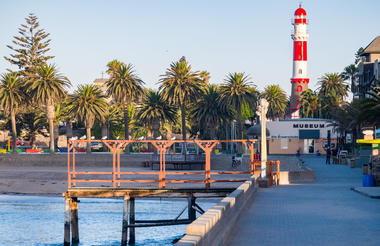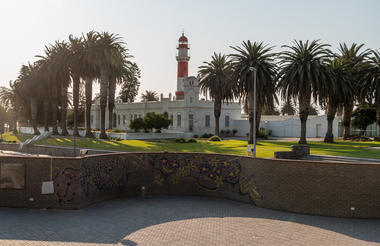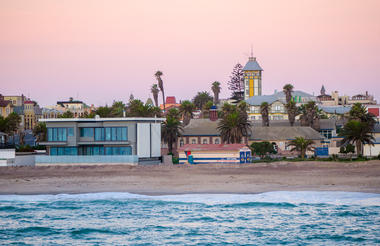Welcome to Swakopmund, Namibia’s coastal gem where history and adventure collide in the most spectacular way! Nestled along Namibia's breathtaking coastline, this charming seaside town boasts wide-open avenues, colonial architecture, and a backdrop of otherworldly desert landscapes. Established in 1892 as the main port for German South West Africa, Swakopmund has retained a unique German flair that feels almost more authentic than Germany itself. Its quaint buildings and nostalgic charm make it feel like a step back in time.
Swakopmund's architecture, nestled between the vast desert and the rolling ocean, echoes its German colonial roots. But don’t let the historic vibe fool you—this town is alive with excitement and a relaxed beachside ambiance. Think palm trees, pleasant promenades, and gardens where the sea breeze keeps things cool and refreshing.
Today, Swakopmund is the bustling heart of Skeleton Coast tourism, and there’s no shortage of thrilling activities to dive into. Whether you're into quad biking through the dunes, horseback riding along the coast, paragliding over stunning landscapes, or casting a line in the ocean, Swakopmund has got you covered. For those who prefer exploring, the fascinating desert tours offer a unique look at the region’s natural wonders.
Gear up for a thrilling experience in the vibrant town of Swakopmund, for a mix of history, adventure, and laid-back charm in Swakopmund—where every corner promises a new discovery!

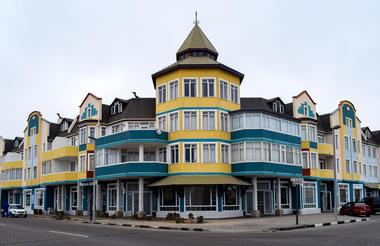
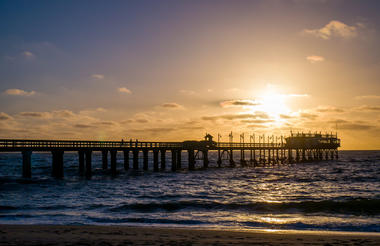
Nestled just a few hours' drive from Namibia’s bustling capital, Windhoek, the Erongo Mountain Range is a breathtaking escape into nature's grandeur. Stretching majestically between the towns of Omaruru and Karibib, this rugged wilderness is a treasure trove of natural beauty and adventure, offering a rich tapestry of experiences for every kind of traveler.
Imagine exploring an expanse of dramatic landscapes where ancient granite peaks rise above rolling plains, creating a stunning backdrop for outdoor adventures. The Erongo Mountains are renowned for their spectacular scenery, with awe-inspiring caves and rock paintings that whisper tales of centuries past. These ancient sites, etched into the rock, offer a unique glimpse into the region’s rich cultural heritage.
The mountain range is also home to a vibrant array of wildlife. Encounter majestic rhinos, and elusive leopards in their natural habitat. Marvel at the grace of giraffes, the speed of cheetahs, and the diversity of over 200 bird species that call this area home. Whether you're spotting wildebeests, impalas, or the elusive mountain zebra, the Erongo Mountains promise a wildlife experience like no other.
Adventure seekers will find plenty to thrill their senses. Hike through rugged trails, scale impressive rock faces, or embark on exhilarating game drives. For a different perspective, saddle up for a horse riding safari across the dramatic terrain or hop on a mountain bike to explore the varied landscapes. The Erongo Mountains offer something for everyone, whether you're looking for a heart-pounding adventure or a serene escape into nature’s splendor.
With its rich blend of natural beauty, historical significance, and thrilling activities, the Erongo Mountain Range invites you to experience Namibia in all its majestic glory.
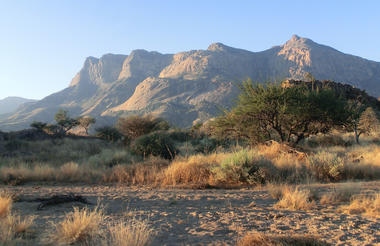
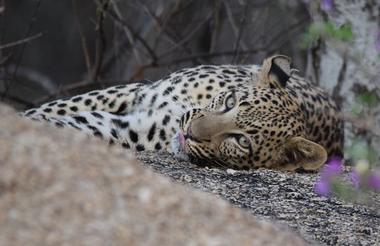
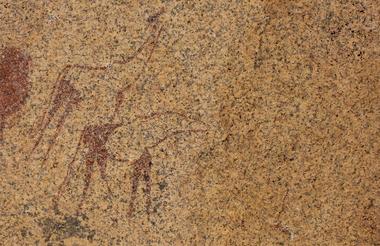
Situated in Namibia’s desolate, awe-inspiring Namib Desert, between Usakos and Swakopmund and about two hours’ drive from Swakopmund, the Spitzkoppe are a group of bald granite peaks forming one of Namibia’s most recognizable and dramatic landmarks. These enormous towering domes are a mecca for hikers and mountaineers, from beginners interested in guided historic walks to professional climbers seeking an adrenaline boost. Numerous ancient rock paintings can be visited as part of a guided walking tour. The extreme, barren landscapes and striking rock formations create an excellent setting for photography.
The 1728m high Spitzkoppe is one of Namibia’s most recognizable landmarks, rises mirage-like above the dusty pro-Namib plains of southern Damaraland. Its dramatic shape has inspired its nickname, the Matterhorn of Africa.
Towering 600 to 700 m above the Namib Plains, the rocky fastnesses of Gross and Klein Spitzkoppe and the Pontok Mountains are prominent landmarks north of the of Usakos - Henties Bay road. Like Brandberg and Erongo, these spectacular granite stocks formed as a result of tectonic and magmatic activity some 135 million years ago, which eventually led to the opening of the South Atlantic Ocean and the separation of Africa and South America. While Klein Spitzkoppe is well known among mineral collectors for the occurrence of gem-quality topaz, aquamarine and other semi-precious stones, the sheer granite faces of the Gross Spitzkoppe attract many rock climbing enthusiasts, causing it to be dubbed the „Matterhorn of Africa”. „Bushman’s Paradise” at the eastern end of the nearby Pontok Mountains is one of several rock art sites in Namibia that enjoy National Monument status.
Emplacement of the Spitzkoppe and Pontok granites in metamorphic schists and marbles of the ca. 650 million year old Damara Supergroup overlain by the much younger Karoo sediments during break-up of the Gondwana supercontinent was preceded by a period of increased basaltic-rhyolitic magmatism. Numerous predominantly northnorth-east trending dyke swarms bear witness of these events and are easily recognisable on air photos and satellite images as prominent dark ridges. Over millions of years erosion patiently and inexorably wore away the Karoo and Damara country rocks, and chiselled the exposed granite intrusive rocks into the striking topographic features visitors see today.
The Spitzkoppe granites display some interesting erosional forms, sculpted by the persistent west wind and extreme temperature differentials between night and day. Perhaps the best-known of these is the spectacular rocky „Bridge“, while the rounded shapes of the neighbouring Pontok Mountains reminded early explorers of the huts built by the local people (“pontoks“). Also typical of granitic rocks in subtropical regions is a feature known as “onion-skin weathering” - following concentric joints formed in the cooling and solidifying magma, layer after layer of weathered rock „peels“ away, producing characteristic rounded boulders.
Klein Spitzkoppe is one of the best known mineral localities in Namibia. For more than a hundred years semi-precious stones such as topaz, aquamarine and green fluorite have been mined from pegmatites and their erosional products in small diggings by the local population.
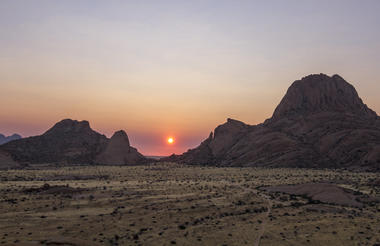
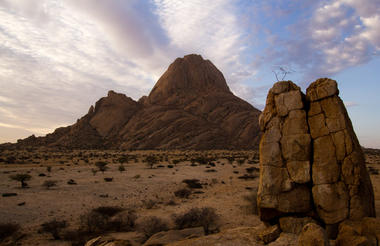
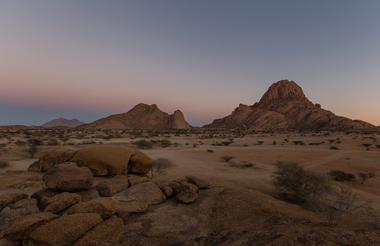
As previously described
